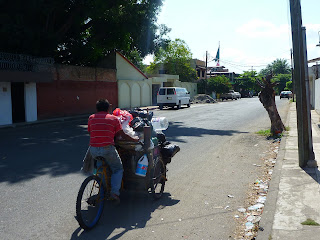But first, a copy of Latin American road rules...This following is actually an excerpt from an English language mini-mag for Spanish students and tourists in Quetzeltenango (Xela), Guatemala. The article wrote about the Guatemalan road rules but we felt they could be equally applied to everywhere we went in central America (so for the purposes of our blog I have substituted Latin America for Guatemala everywhere it appeared…)
The road rules of Latin America:
There is probably no more succinct argument for the viability of anarchy as a system of social organisation than the unofficial road rule system of latin America. Consider the state of the roads and the vehicles, the near-complete lack of police and licensed drivers and then consider that there are barely enough chicken bus crashes to keep Nuestro Diario in front page photos on a daily basis (if you read our blog on our week in Guatamala, you'll get the reference to chicken buses). But still, some foreigners appear to be taken aback by what goes on, and they should be aware that, running parallel to the Ley de Tránsito is a whole other set of Rules. We elaborate:
Insurance: Nobody has any, and everybody knows that nobody else has any. Accidents are therefore avoided at all costs.
Roadworthiness: If you can get it on the road, its worthy. Next question.
Indicators: Not to be used for ANY turning-related activity. If used for something else, leave on for rest of journey
Right of way: 1. The larger vehicle shall always have right of way. Pedestrians and cyclists: watch your back front and sides. 2. Inserting any part of the vehicle into the traffic stream immediately establishes right of way, requiring all oncoming traffic to come to a screaming holt. Note that clause 1 overrides clause 2.
Merging: to avoid unlawful use of indicators, express the wish to merge by waving arm out of window. Wave frantically to express the fact that you have sincere desire to merge and are not just playing around.
Overtaking: Wherever, whenever. The double yellow line in the middle can be used as a guide for the centre of your vehicle should you decide to overtake a blind corner and a chicken bus appears in the oncoming lane.
Roundabouts: Much like the g-spot, everybody is fairly certain that these exist but very few people know what to do with them. Continuing the analogy, enter with caution, proceed gently and try to exit without major mishap
Breakdown: In the case of vehicle breakdown half pull your vehicle off the road just around the next bend and leave some twigs on the road to warn other drivers. DO NOT for any reason, pick up these twigs later.
Hazard Lights: The ‘time out’ of the latin American road rule system. Use these to denote that you’re about to do some completely random business that nobody else have ever even though of, like reversing around a corner at 50 miles per hour onto a busy street while sending an SMS.
 |
| The local indigenous ladies would walk miles with supplies on their heads for selling at the local markets |
 |
| This guy would appear in Tapachula semi-regularly, he was obviously from a property out of town and would come in to pick up supplies. |
The below three photos are bike businesses from Tapachula.
 |
| The Pan Man |
 |
| Basura man |
 | |
| Bike of another basura man |
 |
| Pizza delivery, sales rep vehicles......little scooters were popular. |
 | |||
| Again little motorbikes used for people moving, but these ones are mass produced vehicles |
Old VW beetles and bay window combis were very popular. The following group of photos is a display of the differing conditions of VWs that Steve found during our travels.
 |
| No front guard, no worries. |
 |
| The quality in the photos shows the quality of cars, the white one above was found in Oaxaca and was in mint condition. |
 |
| Most combis had their engine system upgraded to a water cooled engine as seen by the radiator in the front of the van. |
 |
| Combis as ice cream vendor vehicles. In fairness this is a lot better than the old bedford vans around home, this one didnt blow smoke either but still played music that kids ran to find. |
The American trucks were a pleasant find, the drive down from the States in these gas guzlers would be very expensive though








No comments:
Post a Comment